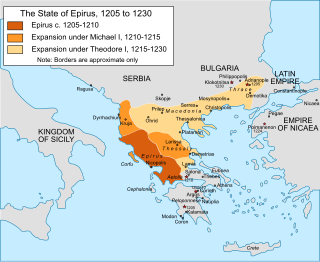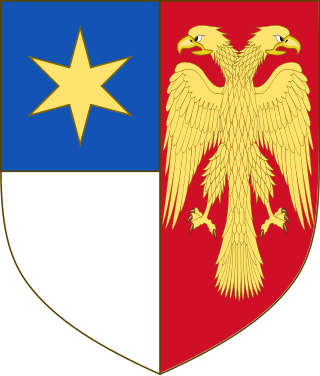
The Despotate of Epirus was one of the Greek successor states of the Byzantine Empire established in the aftermath of the Fourth Crusade in 1204 by a branch of the Angelos dynasty. It claimed to be the legitimate successor of the Byzantine Empire during the subsequent struggle for Constantinople, along with the Empire of Nicaea and the Empire of Trebizond; its rulers briefly proclaiming themselves as Emperors in 1227–1242. The term "Despotate of Epirus" is, like "Byzantine Empire" itself, a modern historiographic convention and not a name in use at the time.

Thomas Preljubović was ruler of the Despotate of Epirus in Ioannina from 1367 to his death in 1384. Thomas was an unpopular ruler and is appraised very negatively by his contemporaries. On December 23, 1384 he was stabbed to death by his guards at dawn. The conspiracy of the faction which overthrew him involved his wife Maria Angelina who succeeded him.

Esau de' Buondelmonti was the ruler of Ioannina and its surrounding area from 1385 until his death in 1411, with the Byzantine title of despot.
Carlo I Tocco was the hereditary Count Palatine of Cephalonia and Zakynthos from 1376, and ruled as the Despot of Epirus from 1411 until his death on July 4, 1429.
Carlo II Tocco was the ruler of Epirus from 1429 until his death.

Gjin Bua Shpata was an Albanian ruler in Western Greece with the title of Despot. Together with Pjetër Losha, he led raids into Epirus, Acarnania and Aetolia in 1358. He was recognized as Despot by the titular Eastern Roman Emperor in the early 1360s and ruled Aetolia (1360s–?), Angelokastron (?–1399), Naupactus (1378–1399), and Arta (1370s–1399). He was born sometime in the first half of the 14th century in Epirus, as his father was a ruler in the region.

The Despotate of Arta was a despotate established by Albanian rulers during the 14th century, after the defeat of the local Despot of Epirus, Nikephoros II Orsini, by Albanian tribesmen in the Battle of Achelous in 1359. The Despotate ceased to exist in 1416, when it passed to Carlo I Tocco.
Muriki or Maurice Shpata was the ruler of Arta from late 1399/early 1400 until his death in 1414 or 1415. Muriq’s reign was dominated by his wars with Carlo I Tocco. Muriq was able to defend his capital of Arta, but despite some victories failed to prevent the fall of Ioannina to Tocco. As a result, his brother Yaqub Shpata who succeeded him was defeated in October 1416, ending the Despotate of Arta.

The Bua were a medieval Albanian tribe. The name is first attested in 14th-century historical documents as one of the Albanian tribes living in the Despotate of Epirus. Later on, the Bua settled southwards in the Peloponnese, and a part of them found refuge in Italy in the Arbëreshë migrations that followed the Ottoman conquest of the Balkans. A branch of the tribe regiments was ennobled in the Holy Roman Empire after its service in the Stratioti, a Balkan mercenary unit. Mërkur Bua, its most prominent member, was Count of Aquino and Roccasecca.

Pjetër Losha was an Albanian clan leader in medieval Epirus. He belonged to the Losha fis and was the leader of a combined force of his own clan and the fis of Mazaraki and Malakasi. In 1360, he became Despot of Arta, Rogoi and the area of Amphilochia. He died in 1374 and was succeeded by his close ally, Gjin Bua Shpata. The Chronicle of the Tocco is an important primary source for his life and the Albanians in medieval Epirus in general.
The term Albanian Principalities refers to a number of principalities created in the Middle Ages in Albania and the surrounding regions in the western Balkans that were ruled by Albanian nobility. The 12th century marked the first Albanian principality, the Principality of Arbanon. It was later, however, in the 2nd half of the 14th century that these principalities became stronger, especially with the fall of the Serbian Empire after 1355. Some of these principalities were notably united in 1444 under the military alliance called League of Lezhë up to 1480 which defeated the Ottoman Empire in more than 28 battles. They covered modern day Albania,western and central Kosovo, Epirus, areas up to Corinth, western North Macedonia, southern Montenegro. The leaders of these principalities were some of the most noted Balkan figures in the 14th and 15th centuries such as Gjin Bua Shpata, Andrea II Muzaka, Gjon Zenebishi, Karl Topia, Andrea Gropa, Balsha family, Gjergj Arianiti, Gjon Kastrioti, Skanderbeg, Dukagjini family and Lek Dukagjini.

John Zenevisi or Gjon Zenebishi was an Albanian magnate that held the estates in Epirus, such as Gjirokastër and Vagenetia.
Sgouros Shpata was the Lord of Arta briefly in 1400, and the Lord of Angelokastron from 1401 until his death in 1403, during warfare in a civil war.

The Malakasi were a historical Albanian tribe in medieval Epirus, Thessaly and later southern Greece. Their name is a reference to their area of origin, Dangëllia in southern Albania, centered around the village of Malakas, on the Western slope of mount Radomir. They appear in historical records as one of the Albanian tribes which raided and invaded Thessaly after 1318 and throughout the 14th century were active in the struggles of the Albanian Despotate of Arta against the Despotate of Epirus.
Simon Zenebishi was an Albanian aristocrat and vassal of the Kingdom of Naples, who held the castle of Strovilo (Castrovilari), near Butrint, and was a member of the Zenebishi family of southern Albania. He probably dwelled in Corfu, and was later subject to the sovereignty of Alfonso of Naples.
The Spata family was an Albanian noble family which rose to prominence in the 14th, 15th and 16th centuries, initially as Venetian vassals and later as Ottoman vassals. The family's progenitors were the brothers Gjin Bua Shpata and Skurra Bua Shpata. Shpata means "sword" in Albanian.
The Albanian-Epirote War of 1374–75 was waged between the Despotate of Arta, led by Gjin Bua Shpata and the Despotate of Epirus, led by Thomas II Preljubović.
The Albanian-Epirote War of 1381–84 was waged between the Despotate of Arta, led by Gjin Bua Shpata, and the Despotate of Epirus, led by Thomas II Preljubović. During the war, Thomas would be given the nickname "Albanian-slayer", due to the cruelty he displayed towards Albanian prisoners.
The Knights Hospitaller invasion of the Despotate of Arta was a military campaign conducted by the Knights Hospitaller, led by Grand Master Juan Fernández de Heredia. The campaign targeted the Despotate of Arta, ruled by Gjin Bua Shpata. The invasion was sanctioned by Pope Gregory XI.
The Albanian invasion of Epirus (1411–1412) was a military campaign led by Albanian chieftains Gjon Zenebishi, Lord of Gjirokastër, and Muriq Bua Shpata, Despot of Arta, against the Despotate of Epirus.






